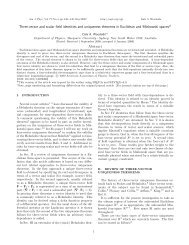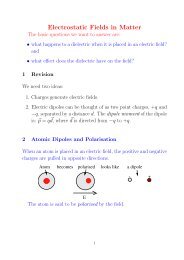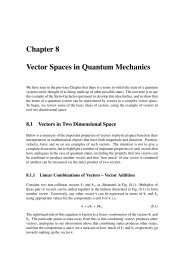AOS News - The Australian Optical Society - Macquarie University
AOS News - The Australian Optical Society - Macquarie University
AOS News - The Australian Optical Society - Macquarie University
- No tags were found...
You also want an ePaper? Increase the reach of your titles
YUMPU automatically turns print PDFs into web optimized ePapers that Google loves.
<strong>AOS</strong> <strong>News</strong> Volume 25 Number 1 2011Figure 3. Polarisation rotation as a function ofinput frequency and power.Further details of the design and theexperimental techniques can be foundin [2].We note that the angle of twist isan important parameter, which notonly determines the magnitude of thegyrotropy [1], but also changes theresonant frequency of the metamoleculedue to strong near-field interactions [5].In general chiral and anisotropic structureshave elliptically polarised eigenmodes,leading to a complex dependence of thepolarisation state of the transmitted waveon the incident polarisation state. Weobserved no change of our results whenthe metamolecule was rotated along itsaxis in the cylindrical waveguide. Thisindicates that anisotropic, birefringenceeffects are negligible and the polarisationchange is dominated by the circulardichroism and circular birefringence ofthe sample. This allows us to describe thetransmission in terms of the transmissionof the left- and right-handed circularlypolarised waves, T-- and T++.Figure 3 show polarisation rotationof a linearly polarised wave for differentincident intensities. <strong>The</strong> resonant featurecomes from the resonant excitation ofFigure 4. Difference between forward andbackward transmission for the optical diode.currents in the left-handed metamoleculeby the left-handed circularly polarisedwave. Our numerical simulations confirmthat the excited resonance corresponds toout-of-phase currents in the wires. At thesame time, the right-handed circularlypolarised wave does not noticeably exciteany resonances in our structure. Changingthe power of the incident wave shifts theresonance of the gyrotropic response to ahigher frequency. Importantly, such a shiftof the polarisation rotation resonance leadsto giant nonlinear gyrotropy. This can becalculated as achieving a peak value of 15deg°/W, which is 12 orders of magnitudestronger than results previously observedfor LiIO3, at optical wavelengths [4].<strong>Optical</strong> Diode for CircularlyPolarised WavesIf we modify the structure suchthat only one wire contains a nonlinearinclusion, then it will have a lowersymmetry, and we can use this featurein order to allow the propagation ofleft-handed circularly polarised wavesin one direction only. This relies on thenon-reciprocity of nonlinear components,which becomes significant at higher inputpowers. <strong>The</strong> results of our measurementsfor the left-handed circularly polarisedwave scattering on a left-handed chiralmetamolecule are shown in Figure 4.When the amplitude of the incidentwave is small, the structure shows alinear response, and the transmissioncoefficients in both directions are equal.However, in the nonlinear regime, withhigh intensity of the impinging wave weobserve considerably different transmissionproperties in opposite directions with themaximal intensity contrast between thetwo directions of 18 dB. Our numericalmodelling shows that such behaviourresults from significantly different currentamplitudes induced in the two wire stripsby the waves entering the metamoleculefrom one direction, in comparisons witha much smaller excitation differenceproduced by a wave entering from theopposite direction. <strong>The</strong> ‘polarity’ of themetamaterial diode depends on theoperating frequency: In the range 5.9 - 6.0GHz the transmission for the left-handedcircularly polarised wave is greater in theforward direction, i.e. when the wave hitsthe strip with the nonlinear element first.However, in the range from 6.0 GHz to6.3 GHz the ‘polarity’ reverses and thediode transmits the same polarisation inthe opposite direction only.ConclusionWe have demonstrated a metamaterialshowing significant nonlinear opticalactivity, an effect which is extremely weakin natural materials. We then modified thisstructure to create an asymmetric version,which acts as an optical diode for circularlypolarised waves, allowing transmission ofthe left-handed circular polarisation onlyin one direction.AcknowledgementsThis work was supported by the<strong>Australian</strong> Research Council, by the<strong>Australian</strong> Academy of Science TravelGrant, and by the Engineering andPhysical Sciences Research Council UKand <strong>The</strong> Royal <strong>Society</strong> (London).References[1] A.V. Rogacheva, V.A. Fedotov, A.S.Schwanecke, and N.I. Zheludev, “GiantGyrotropy due to Electromagnetic-Field Coupling in a Bilayered ChiralStructure,” Physical Review Letters,vol. 97, Oct. 2006, pp. 1-4.[2] I.V. Shadrivov, V.A. Fedotov, D.A.Powell, Y.S. Kivshar, and N.I.Zheludev, “Electromagnetic waveanalogue of an electronic diode,” NewJournal of Physics, vol. 13, Mar. 2011,p. 033025.[3] S.A. Akhmanov and V.I. Zharikov,“Nonlinear optics of gyrotropicmedia,” JETP Lett., vol. 6, 1967, pp.137-140.[4] S.A. Akhmanov, B.V. Zdanov, N.I.Zheludev, N.I. Kovrigin, and V.I.Kuznetsov, “Nonlinear optical activityin crystals,” JETP Lett., vol. 29, 1979,pp. 264-268.[5] M. Lapine, D.A. Powell, M.V.Gorkunov, I.V. Shadrivov, R. Marqués,and Y.S. Kivshar, “Structural tunabilityin metamaterials,” Applied PhysicsLetters, vol. 95, 2009, p. 084105.David A. Powell, Ilya V. Shadrivov and YuriS. Kivshar are with the Nonlinear PhysicsCentre and CUDOS@ANU, ResearchSchool of Physics and Engineering, ANU,Canberra. Vassili A. Fedotov and NikolayI. Zheludev are with the OptoelectronicsResearch Centre and Centre for PhotonicMetamaterials, <strong>University</strong> of Southampton,United Kingdom.29
















